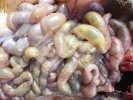Transmissible gastroenteritis
Transmissible gastroenteritis is a very important and highly infectious disease in pigs, with severe impact in reproduction, where diarrhea can cause a 100% mortality in piglets younger than 2 weeks of age.
Alternative names: TGE
Information
Transmissible gastroenteritis is a very important and highly infectious disease in pigs, and is caused by a coronavirus. Its clinical presentation is identical to the epidemic porcine diarrhea, also caused by a coronavirus. The virus can survive for a long time outside the pig in cold weather. It is susceptible to disinfectants, mainly iodine based, quaternary ammonium and peroxide compounds.
The disease persists in the farrowing crates for 3 to 4 weeks until the sows have developed enough immunity to protect the piglets.
Clinical presentation in susceptible animals is diarrhea and vomiting.
In finishing units of a higher size where susceptible animals enter constantly, the virus is maintained indefinitely in the population through repeated infection of arriving pigs. Transmissible gastroenteritis can end up being endemic (mild presentation), thus presenting a high morbidity but a low mortality.
Symptoms
Sows
- In acute outbreaks the main and most important feature is the speed it is disseminated in the animals.
- Vomiting.
- Diarrhea.
- Adult animals show variable degrees of loss of appetite and normally recover in 5 to 7 days.
Lactating piglets
- Severe disease in lactating animals.
- Acute watery diarrhea.
- Mortality of almost 100% in 2 to 3 days for the piglets 14 days old or younger due to a severe dehydration and electrolytes imbalance.
- There is no response to antibiotics.
- The most important feature is the wet and dirty appearance all the litter has due to the profuse diarrhea.
Weaners and growers
- When the virus enters a finishing farm for the first time, it is rapidly transmitted producing vomiting and watery diarrhea that affects almost all animals.
- Often times, the clinical presentation is very mild and is confused with an ileitis outbreak.
- The disease spontaneously disappears in a few days.
- Usually mortality is low.
- Despite of it all, the disease can delay the slaughter weight 5 to 10 days.
Causes / contributing factors
- Large amounts of the virus are excreted through feces.
- Thus, feces are the main source of transmission, directly through carrier pigs or indirectly through mechanical transmission.
- Flooring in bad shape.
- Bad hygiene in pens associated to inadequate drainage.
- Environment contamination that can be passed from one pen to another through boots, brushes, shovels, clothes, etc.
- Silo’s pipes. This is a high risk form of transmission of enteric diseases.
- Dogs can excrete the virus in their feces during 2 to 3 weeks.
- Birds, especially starlings can transfer the disease.
- Contaminated feed.
- Continuous use of pens. Not using the all-in/all-out system may preserve the disease.
- Continuous purchase of weaned pigs that have not had previous contact with the virus.
- Outbreaks are most common during winter because the virus survives best in cold weather-
- Outbreaks during summer are rare.
Diagnosis
The clinical picture of the acute disease is almost pathognomonic. Except for the epidemic porcine diarrhea, there are no other enteric diseases so rapidly transmitted, and that cause high mortality in piglets. Final diagnosis must be made in the lab from samples of the intestine of a recently death pig using fluorescent antibodies test. PCR in feces can also be used. Serology interpretation is complicated due to a crossed reaction with respiratory coronavirus antibodies, which is a common disease that only affects the respiratory system.
Control/Prevention
- There is not a specific treatment for transmissible gastroenteritis.
- Supply electrolytes and an easy access to water to prevent dehydration, along with an antibiotic, for example neomycin.
- Care and Iimprovement of the litter enviroment by supplying a better heat source, and a good bedding in order to reduce the severity of the infection.
- Although vaccines use helps decrease mortality, vaccines are not very effective, and the immunity does not last long.
- Biosecurity is critical, especially during winter.
Atlas of pathology
See images in the Altlas related to Transmissible gastroenteritis




